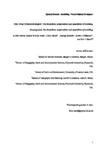Feral Political Ecologies?: The Biopolitics, Temporalities and Spatialities of Rewilding
| dc.contributor.author | Wynne-Jones, S | |
| dc.contributor.author | Clancy, C | |
| dc.contributor.author | Holmes, G | |
| dc.contributor.author | O’Mahony, K | |
| dc.contributor.author | Ward, Kimberley | |
| dc.date.accessioned | 2020-06-26T09:55:44Z | |
| dc.date.available | 2020-06-26T09:55:44Z | |
| dc.date.issued | 2020-05-05 | |
| dc.identifier.issn | 0972-4923 | |
| dc.identifier.issn | 0975-3133 | |
| dc.identifier.uri | http://hdl.handle.net/10026.1/15816 | |
| dc.description.abstract |
In an era of escalating environmental change and degradation, rewilding has emerged as an innovative, hopeful, and increasingly popular form of conservation capturing the imagination of both publics and professionals alike, but equally courting controversy (Lorimer 2015; Jepson 2018; Pettorelli et al. 2018). Rewilding is aligned with restorative practices promoting landscape fluidity, connectivity and non-equilibrium ecologies (Manning et al. 2009; Zimmerer 2000; Lindenmayer and Fischer 2013). However, given its emphasis on nonhuman autonomy, and a reduction in human intervention and control, rewilding can be seen as a distinct and novel strategy distinguished from traditional forms of ecological restoration (Arts et al. 2016; Prior and Ward 2016). Continuing to evolve since its introduction in the late 1990s (Soule and Noss 1998; Foreman 2004; Taylor 2005), this growing movement has provided a plural and, for some, confusing multiplicity of agendas (Jørgensen 2015). Broadly speaking, some differences originate from divergent ontologies of wild(er)ness and the historic influence of humans in co-producing ‘natural’ landscapes (Drenthen 2018; Ward 2019). This can distinguish North American and European forms of rewilding, the latter of which provides the geographical focus for this collection. The aim of creating healthier, more resilient, and largely self-willed ecosystems is, however, apparent as a unifying agenda (Gammon 2018; Pettorelli et al. 2018) moving away from the compositionalist and territorialised strategies of traditional conservation, towards a focus on ecological functionality and processes (Sandom et al 2013; Lorimer et al. 2015; Jepson 2016). | |
| dc.format.extent | 71-71 | |
| dc.language | en | |
| dc.language.iso | en | |
| dc.publisher | Medknow | |
| dc.title | Feral Political Ecologies?: The Biopolitics, Temporalities and Spatialities of Rewilding | |
| dc.type | journal-article | |
| dc.type | Review | |
| dc.type | Journal | |
| plymouth.author-url | https://www.webofscience.com/api/gateway?GWVersion=2&SrcApp=PARTNER_APP&SrcAuth=LinksAMR&KeyUT=WOS:000542133700001&DestLinkType=FullRecord&DestApp=ALL_WOS&UsrCustomerID=11bb513d99f797142bcfeffcc58ea008 | |
| plymouth.issue | 2 | |
| plymouth.volume | 18 | |
| plymouth.publication-status | Published | |
| plymouth.journal | Conservation and Society | |
| dc.identifier.doi | 10.4103/cs.cs_20_67 | |
| plymouth.organisational-group | /Plymouth | |
| plymouth.organisational-group | /Plymouth/Faculty of Science and Engineering | |
| plymouth.organisational-group | /Plymouth/Faculty of Science and Engineering/School of Geography, Earth and Environmental Sciences | |
| plymouth.organisational-group | /Plymouth/REF 2021 Researchers by UoA | |
| plymouth.organisational-group | /Plymouth/REF 2021 Researchers by UoA/UoA14 Geography and Environmental Studies | |
| plymouth.organisational-group | /Plymouth/Research Groups | |
| plymouth.organisational-group | /Plymouth/Research Groups/Centre for Research in Environment and Society (CeRES) | |
| plymouth.organisational-group | /Plymouth/Research Groups/Centre for Research in Environment and Society (CeRES)/CeRES (Reporting) | |
| plymouth.organisational-group | /Plymouth/Users by role | |
| plymouth.organisational-group | /Plymouth/Users by role/Academics | |
| dcterms.dateAccepted | 2020-04-07 | |
| dc.rights.embargodate | 2020-7-3 | |
| dc.identifier.eissn | 0975-3133 | |
| dc.rights.embargoperiod | Not known | |
| rioxxterms.versionofrecord | 10.4103/cs.cs_20_67 | |
| rioxxterms.licenseref.uri | http://www.rioxx.net/licenses/all-rights-reserved | |
| rioxxterms.licenseref.startdate | 2020-05-05 | |
| rioxxterms.type | Journal Article/Review |


